|
A short film about our first workshop In Conversation with Dogs.
0 Comments
Our first workshop took place on the 12th-13th of April in Milton Keynes. We worked with the Animal-Computer Interaction Lab at the Open University to think through how participatory design methods might be extended to working with non-humans. This is the fourth in a series of reflections on the workshop from our participants and is written by Richard Coles. 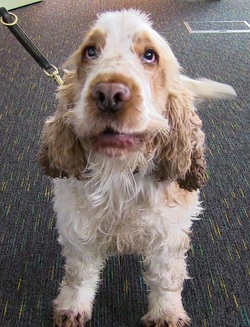 Can you put yourself in the mind-set of a dog and what happens when you do? Attempting to do so is particularly revealing as it requires us to adopt a different perspective to the World, the ways that we see things and the ways that we respond, our encounters and most importantly it challenges our thinking. Let’s look at the process by which we are moved from our ‘hedonistic relationship’ to one which is about making connections. By adopting the stance of a dog and trainer, with only the reward and feedback of a ‘clicker’, it demonstrated that we enter spaces with strong pre-conceptions and a familiarity that was lost. The room changed from a familiar place to one of complete mystery, challenging and uncertain, sensory cues were limited, a new communication of ‘clicks’ was our only feedback, we looked at this small portion of the world from a different perspective. We considered and experienced the interdependence of the dog, trainer, user partnership, the connections made in ways not previously appreciated causing us to question how biased are our existing relationships, and how limited is our communication. Through the involvement of a third party with different physical and social expression, the dogs, it was possible to explore communications, actions and needs from another basis. How did it affect me? It opened up new perspectives requiring/forcing me to consider sensory cues, interaction with the environment. It opened up new possibilities for design options, alternative needs and approaches. Can learn about social and community connections from wider animal worlds? Let us think of a parallel situation, we look to nature for inspiration regarding technology, drug development and art. In the same way, we should be looking at/turning to natural systems and natural relationships from the animal world to examine their societies, relationships and responses in the pursuit of understanding our own society and relationships with anticipated equally informed and dramatic results from which we will learn more about ourselves and how to live in the World. This seems to be a natural progression for society as we continue to explore our own human condition within non-human communities. Many thanks to the ‘Dogs for the Disabled’ an eye opening two days! Our first workshop took place on the 12th-13th of April in Milton Keynes. We worked with the Animal-Computer Interaction Lab at the Open University to think through how participatory design methods might be extended to working with non-humans. This is the third in a series of reflections on the workshop from our participants and is written by Clara Mancini. 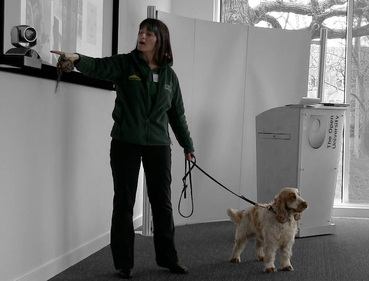 Helen and Willoughby I have been thinking about Deirdre, Owain and Timothy’s very insightful comments about the workshop and ACI ethics protocol, as well as about my own workshop experience [discussions had on the team’s email list after the first workshop – Ed.]. Two questions hover in my mind, against the backdrop of my communication and design background:
An old song from Giorgio Gaber, a cherished Italian author, comes to my mind. The song goes: Freedom is not being perched atop a tree… Could it be that, conversely, participation is a ‘quantum of freedom’ (if you let me get away with the expression)? For example, the freedom to cast a vote, to engage in a social exchange, to use a piece of technology, perhaps to do something unexpected with it. But the dogs do not choose to participate, so they cannot be participants, many say. But I did not choose to be part of this world, I was pulled into it. Does that mean that I cannot be a participant in the process of designing my life? Can I not make individual choices, even though the biggest choice of all was made for me? And isn’t having a small quantum of freedom to make choices, albeit within a limited space and between limited alternatives, enough to make me a ‘participant’? Winnie was brought into the room, but she chose whom to interact with…would we not take something away from her if we did not regard her choices as the autonomous expression of her participation? Isn’t indeed the way in which we regard and respond to the other’s choices that determine whether they are participating? Isn’t recognising the other’s autonomous agency, in spite of the boundaries that limit it within specific processes, the first step to seeing, hearing and, then, respecting their otherness?
But surely, in order to be participants we need to understand what we are participating in? …or do we? Do I understand the conversations I have? I certainly have the impression that I do, but I have learnt how that is mostly just an impression. What I interpret is inevitably different from what is being transmitted by my interlocutor, yet it is enough to keep the communication process going and, in many cases, to effect what I perceive as constructive change. So are the conversations we have with dogs substantially different from the conversations we have with other humans? Should the interaction of a dog with a computing interface be looked at differently from the interaction of a human with a computing interface? Should their input in the design process be regarded as different? I think not. When interaction designers design computing systems they constrain users’ choices while at the same time making it possible for users to make those choices. Even when users design their own systems their design choices are still constrained by others: by those who made the materials and components they will use, by the educators who informed their knowledge and imagination, and so on. However, through their constraining influences, these other agencies have made it possible for these users to express themselves through specific, concrete designs. Indeed any productive process expresses a unique set of constraints by which it is at the same time limited and enabled. Because these constraints are in turn the expression and the result of an otherness’ situated subjectivity, they can never be fully understood. However, this does not prevent us, and dogs, from using these constraints as the starting point and indeed the building blocks of new productive processes in which we can all participate as autonomous agents. Animal-Computer Interaction aims to give animals a place at the design table. And, no matter how one may presume that they could understand the design process, ACI regards animals as autonomous agents whose constrained choices are to be in turn taken as constraints in a production process. Yes, the design table is dominated by human constraints, because technology has so far been dominated by humans, so for now animals are invited to “communicate with ‘us’” and “influence ‘our’ environments”. However, by inviting animals to make design choices and by treating those choices as the expression of autonomous agents (in other words, by taking them seriously), we open a space in which animals can begin to use our constraints as the building blocks of new forms of communication and new environments. “Freedom is not a free space…freedom is participation”. Participation does not have to, and indeed cannot, take place in a free space. Participation does, and has to, take place in a constrained space which we can never fully understand, but in which we have a small quantum of freedom. This quantum of freedom allows us to make choices which begin to affect productive processes and effect change in unpredictable ways. Giving animals a quantum of freedom at the design table is what ACI aims to do. The image that I remember the most from our workshop is that of Willoughby turning away from his tag to look at us with talkative, curious assertiveness. I can almost hear him say: “I’m here. Who are you? I enjoy playing with my tag, which my human goes out of her way to keep moving for me. However, now, right now, I choose to look at you instead. Look at me. I am who I am. Who are you?” 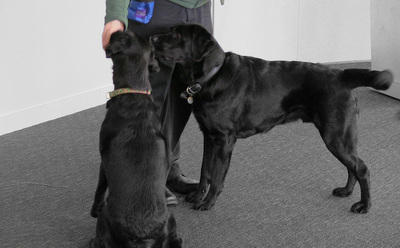 Winnie and Cosmo Our first workshop took place on the 12th-13th of April in Milton Keynes. We worked with the Animal-Computer Interaction Lab at the Open University to think through how participatory design methods might be extended to working with non-humans. This is the second in a series of reflections on the workshop from our participants and is written by Owain Jones. I think the first and basic thing is that the dogs did come into the room, were there for quite a long time and were active. This at least opened up the process to their interventions and agencies. Clearly the handlers were critical mediators between us and the dogs but that is fine. We can’t expect to learn new languages or be comfortable with strangers instantly. All the way through this project and in the wider area of more-than human politics, ethics etc., it makes sense to draw upon those who are ‘expert’ and empathetic in relation to non-humans of one kind or another. The differing behaviours of the dogs as individuals and how they interacted with each other and with the humans present was important to me. [Dogs for the Disabled brought three dogs, two working dogs and one of their own pet dogs – Ed.]. Clearly the dog handlers had their agendas in terms of what they want, need and expect the dogs to do. In terms of participatory research with dogs to respond to particular design needs it would be important to consider the specificities of particular dogs in particular relationships in particular settings. A sort of qualitative ethology of human, non-human, material assemblages. Regarding the clicker exercises we did [see overview here – Ed.], I thought it was sort of interesting doing the clicking but not that interesting being the dog. This was done on the premise (I think) of showing how sharp the dogs are. But I think anyone who watches, and takes various kinds of animals seriously will know they have plenty of abilities / skills / capacities which some sometimes (often) exceed human capacities. We must avoid any cheap notions of becoming-animal, it is not respectful of their otherness, of their ways of being in the world. Speaking of that, the workshops were quite visually orientated, less was made of smell and sound. Of course we can’t get our senses to do what they do but maybe we should have taken a bit of time to watch them smelling and to watch them listening. (If you got a cat – when it is alert – watch its ears as they twitch around focusing on one sound then another). As I said at the time I liked the first session when Winnie was just in the room more or less doing her own thing. And also when Winnie and Cosmo were switching back and forth between the training exercises and doing doggy playing. Haraway (1992) states that ‘biology and evolutionary theory over the last two centuries have…reduced the line between humans and animals to a faint trace’ (193). So because of that – although otherness has to be respected – I don’t think it rocket science to look carefully at animals and get some sense of their intentions, well-being or otherwise – probably true for trees and bees too. I don’t see anthropomorphism as the big impediment to thinking animals and non-humans as other do. There are many shared traits between us. Winnie did a big yawn at one point. For me there are clear continuities between yawning dog and yawning human in terms of affective state. A great video from the Open University about the work of the Animal-Computer Interaction Lab, featuring our recent Conversations with Animals workshop. 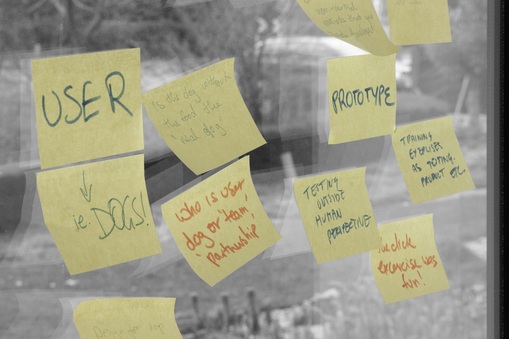 Our first workshop took place on the 12th-13th of April in Milton Keynes. We worked with the Animal-Computer Interaction Lab at the Open University to think through how participatory design methods might be extended to working with non-humans. This is the first in a series of reflections on the workshop from our participants written by Deirdre Heddon. It’s the night after our first ‘More-Than-Human Participatory Research Workshop’. I am sitting in a friend’s living room, explaining the last 48 hours or so. ‘I have been at a workshop at the Open University, led by the Animal-Computer Interaction Team’, I say. ‘We were working with dogs’, I say. ‘Trying to work out how we might work with dogs’, I say. ‘How we might work with dogs as research participants, rather than simply objects of research’, I say. In spite of my gentle approach, there’s a momentary pause, quizzical looks shared across the dinner table. ‘But they can’t be participants, can they, as they haven’t got a choice about being in the workshop?’, responds my friend. ‘It’s true’, I reply, ‘mediating the dogs’ participation were the dogs’ handlers, and indeed, early in the workshop, when we were all introducing ourselves, another participant, a cultural geographer, Owain, did ask why the dogs weren’t in the room with us, there and then, introducing themselves, getting to know us. And Helen, one of the dog handlers, replied that she was checking the space out for the dogs before bringing them in, and checking us out too.’ More quizzical – or might those be sceptical? – looks around the dinner table. More sipping of wine. I try again. ‘As another of the workshop participants, Niamh, said – and I am paraphrasing here – participation should not be presumed to be about equal participation [that’s a fallacy, because power is a dynamic flow – though I didn’t go into this over the dinner table] but about appropriate participation, meaningful participation.’ A few nods now. Emboldened, I continue, ‘So working with dogs as participatory subjects is about taking the dog’s presence, behaviour, responses, actions, activities seriously – it’s about recognising the potential for contribution through recognising the potential for contribution.’ ‘And that can reflect back on how we currently work with humans in research too’, replies C. Bingo. Yes. (In thinking about dogs as participants, we push against some of the assumptions implicit to Human-Computer Interaction.) But it’s not just that. Or it’s more than that. *** 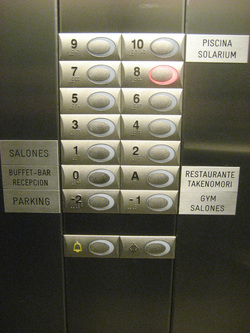 Here is the design problem: ‘Design a button for dogs to use’. Let’s translate that as ‘design a better button’, better for dogs and more-than-dogs. Working with dogs has attuned us to the range and prevalence of buttons/switches in our everyday – the button that releases the door, the buttons on our phones, our remotes, our tablets, the switches on the sockets. A world of buttons. We focus on the buttons that release doors. We reflect on how the dogs – Winnie and Cosmo – had to press their paw to the centre of the mock button before being rewarded (with clicker, treat and positive affirmation ‘Good Boy!’). And how difficult this task is because it demands precision (paws hit the edge, slip off, miss the centre). And this leads us to recognise that the button design unnecessarily focuses attention on a hot spot (Owain has recently downloaded an app to his phone – the Big Red Button app – which demonstrates the button-centre concept perfectly). The button is a bull’s eye, the dead centre, the apocalypse, lift off, jackpot. The button is a cultural repository. But it’s also an unnecessary restriction and challenge. So, imagine the button is replaced by a long, vertical strip. There is no dead centre, no requirement for precision, for a steady and accurate finger or paw. This strip, an extended contact zone, extends the potential for connection between one thing and another. This is our proposed new design but we decide to put functionality aside for now and focus on pleasure. What would a dog like from a strip such as this (textures? smells? activities? challenges?)? What might make the task of contact one of pleasure, engagement, stimulation – beyond the reward of achievement itself (Good Boy!)? We will start with the dogs’ experiences, rather than being led by the necessity of functionality, flipping the instrumental and the aesthetic. And for this, we will need to engage in some deep hanging about with dogs.
Assistance dogs use a variety of objects designed for humans as part of their work. This includes things like door handles and light switches, but also more complicated things like washing machines. One dog in New Zealand had even learnt how to drive a car. These items can be adjusted for dogs to use, by adding a rope to a door handle, for example, but what if you could use methods from participatory design to create interfaces specifically for dogs?
As Clara said today in our discussions, to design with someone (whether this be human or non-human) means coming to a stage where you've recognised that someone as worth catering for, as somebody that has requirements of their own. To design with and for dogs is to also recognise that they are worthy recipients of technology. What we are hoping to do then is to use our workshop as an opportunity to do a test run of a participatory design process with dogs. We will pilot methods of doing an initial exploration and problem definition on the first day, by learning about the kind of relationship that exists between users and the dogs. We'll then focus on how the dogs learn their tasks and in particular how they learn to interact with the different technologies that they use. We'll look for issues, difficulties or complications that arise, as part of defining problems that may need a design solution. On day two we are then planning to work in groups to develop responses to design briefs arising from our problem definition work from the day before. We're hoping to explore how we could support better communication and recognitions of agency through technology designs. Addressing issues around usability, functionality and aesthetics, we are hoping to touch on questions on how to think through the value of design for different species. Given how short our workshop is, we won't have time to test out evaluation methods, but we'll be hearing about some methods that the ACI team have being developing. It's all feeling quite experimental at the moment, and is proving to be both challenging and fascinating. Stay tuned for updates on how it ends up playing out. Michelle Bastian |
Archives
October 2018
Categories
All
Links
Animal Computer Interaction |
Photo used under Creative Commons from cote
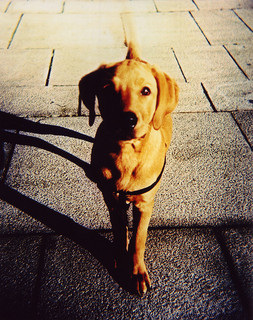
 RSS Feed
RSS Feed
